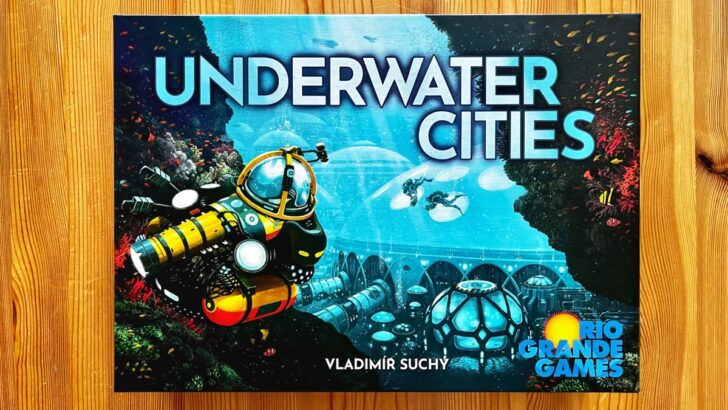Plans have changed; instead of exploring space and Mars for a new planet to live on, humans have moved their efforts for the future underwater.
Read our Underwater Cities review to learn how this big Euro game plays.
Contents
Underwater Cities Overview
In Underwater Cities, 1 to 4 players compete to create the most impressive, self-sustaining underwater network of cities, buildings, and transportation tunnels.
On your turn, you’ll simultaneously play a card from your hand and choose an available action.
If the color of the card you played matches the action you chose, you benefit from both the card and the action slot. If it doesn’t, you simply get to perform the action.
Each round, players take 3 turns. At the end of each of the 3 eras, players’ underwater networks produce resources and points. Moreover, each player must feed their cities during these production phases.
After the tenth round — and the final production phase — players earn additional points for their network, leftover resources, and end-game scoring cards.
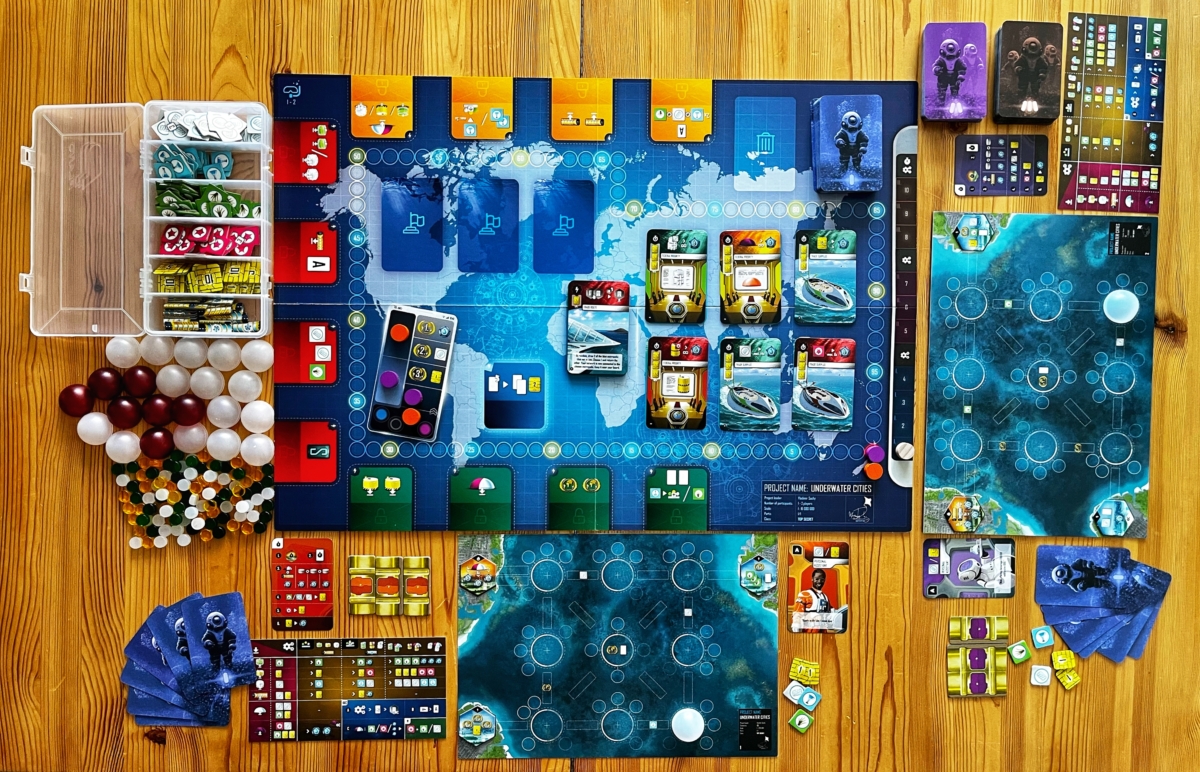
A game of Underwater Cities set up for 2 players. (The Plano box for the resources is not included.) Note: the board is double-sided and the available action slots change depending on the player count.
Underwater Cities Gameplay
Each round, players take turns in order until everyone has taken 3 turns.
Player Turn
You always have 3 cards in your hand at the start of your turn. On a turn, you simultaneously:
- Choose a card from your hand to play and
- Select an available action slot by placing one of your Action tiles on it. (Doing so occupies this action slot for the rest of the round, making it unavailable and blocking other players from taking this action.)
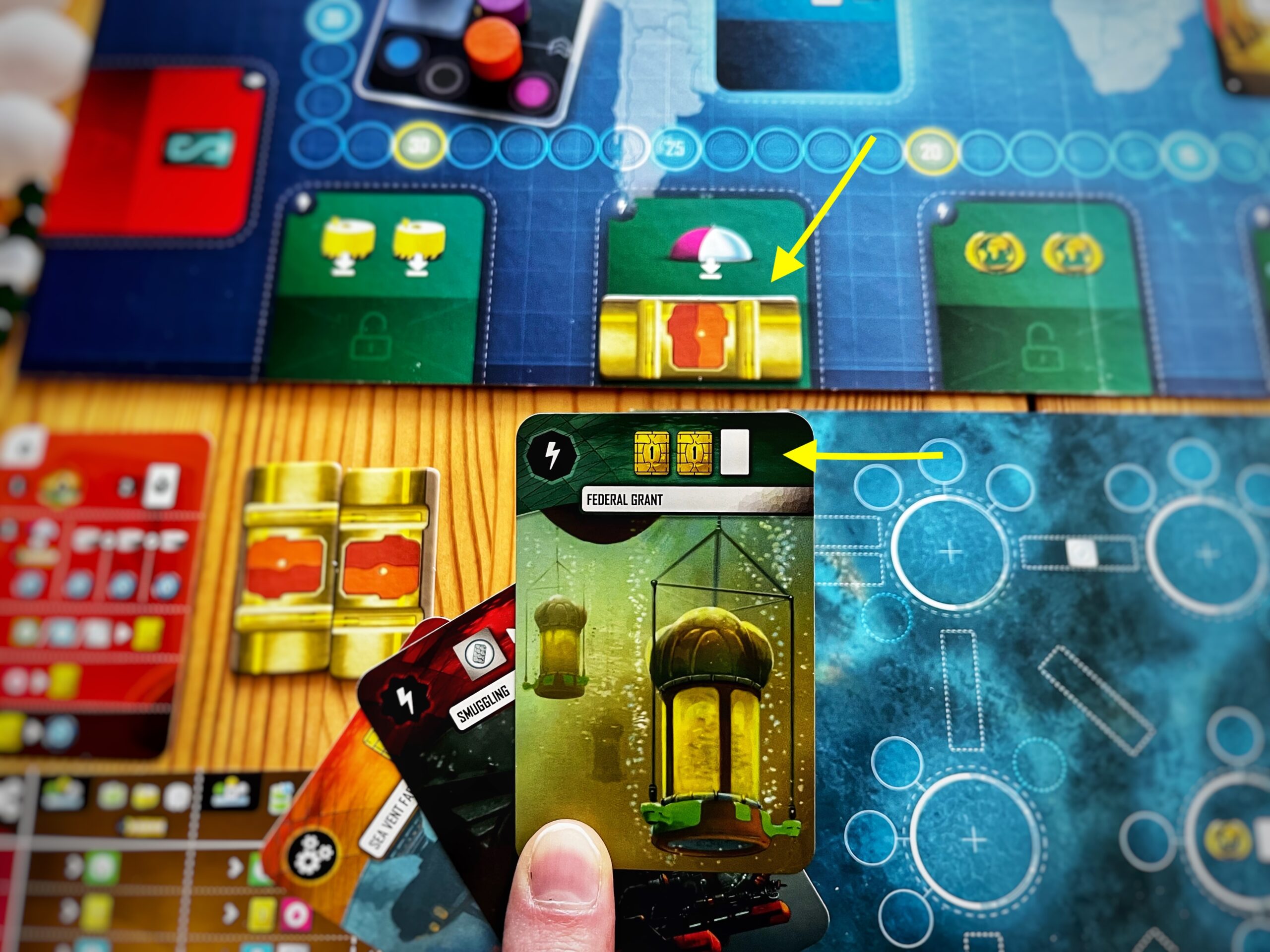
On the orange player’s turn, they play this green “Federal Grant” card and select the available green ‘Cities’ action slot. They mark this by placing their orange Action tile there.
If the color of the card you played matches the color of the action slot you chose, you get the benefits of both the card and the action slot, performing each in whichever order you choose.
Otherwise, if the card doesn’t match the color, it’s discarded.
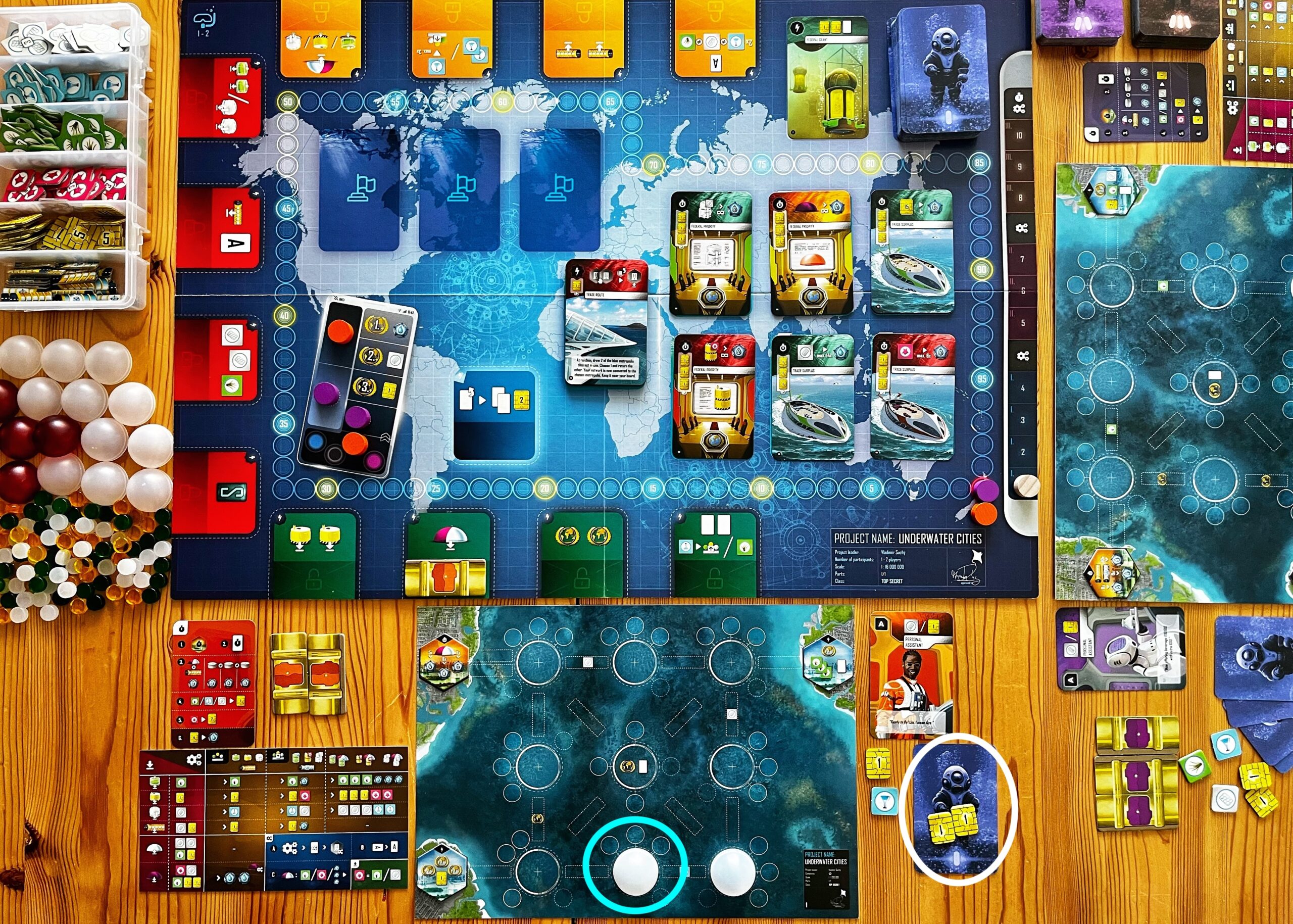
Since the green “Federal Grant” card matches the color of the ‘Cities’ action slot, the orange player resolves both — collecting 2 Credit tokens and drawing 1 card (circled in white) and constructing a City on their player board (circled in light blue).
At the end of your turn, you draw 1 card.
End of Round
Once each player has taken 3 turns, this marks the end of a round. All Action tiles are returned to players, making every action slot available again.
The game is divided into 3 eras — era I, II, and III — that consist of a certain number of rounds (4, 3, and 3, respectively).
At the end of each era, there is a Production phase before the next round begins.
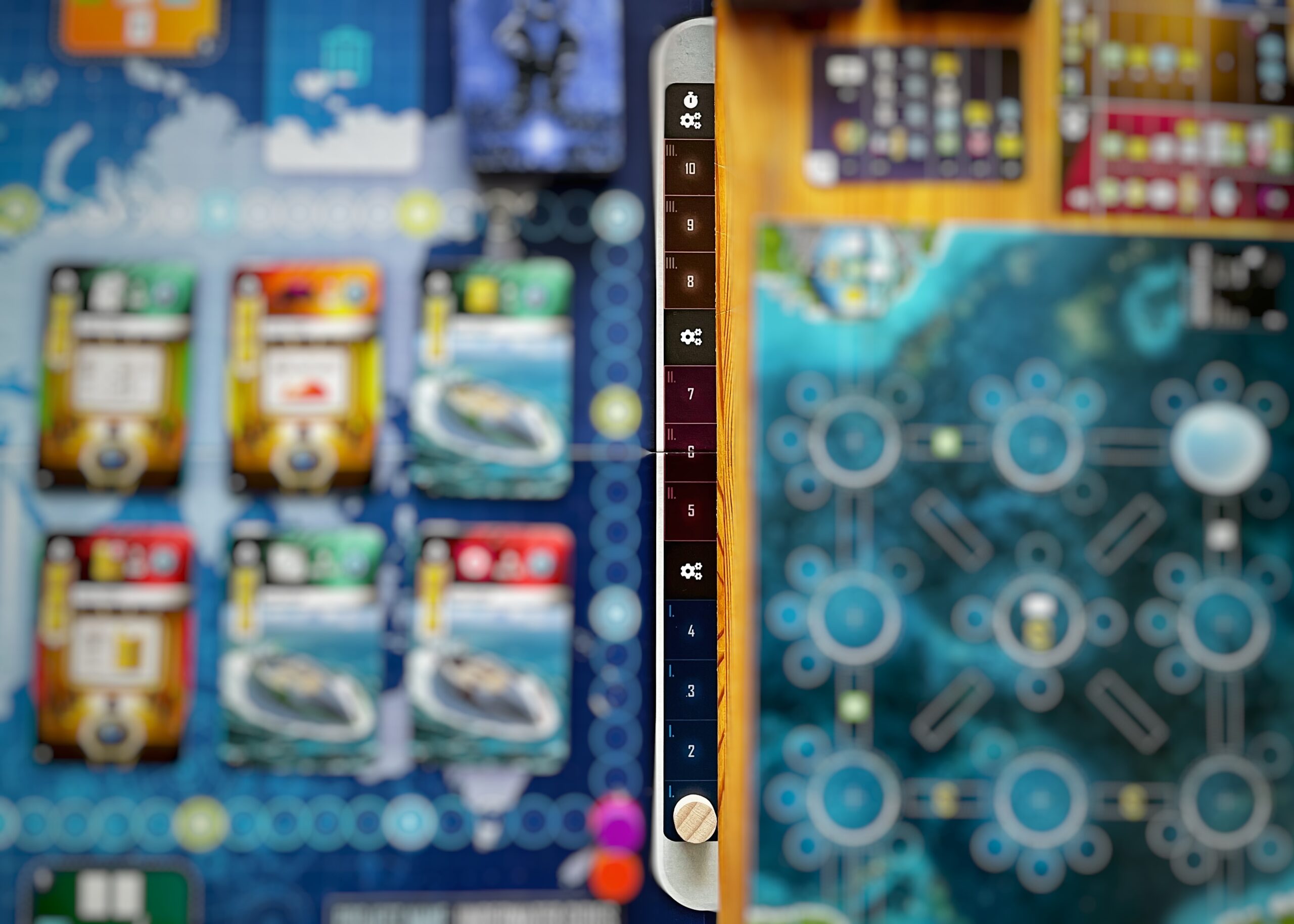
After rounds 4, 7, and 10, there is a Production phase.
A Production phase happens at the end of the 3 eras. During each Production phase, players’ underwater networks produce resources and points.
Additionally, players must feed their connected cities.
Moreover, a new deck of cards enters the game at the beginning of each new era.
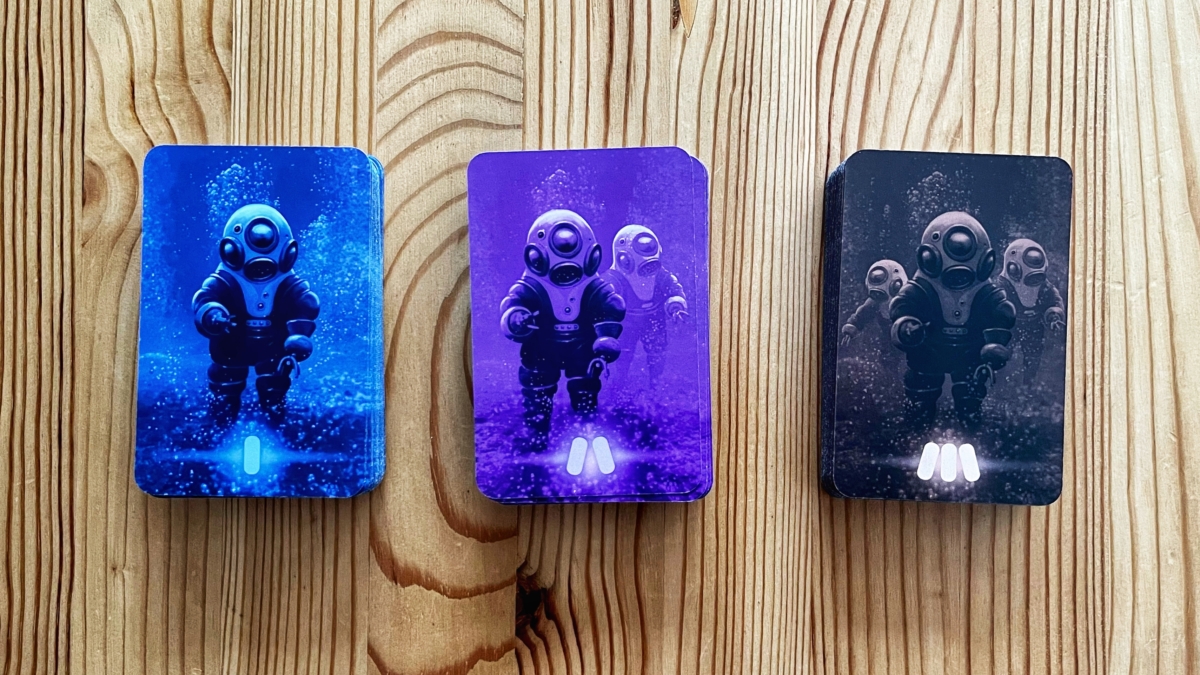
The card decks for eras I, II, and III.
Players proceed to final scoring at the end of era III — or after the tenth round and third Production phase.
Cards
Card play is at the heart of Underwater Cities, so naturally, there are several kinds of cards in the game. Nonetheless, the layout of every card is similar; it’s their effects that vary.
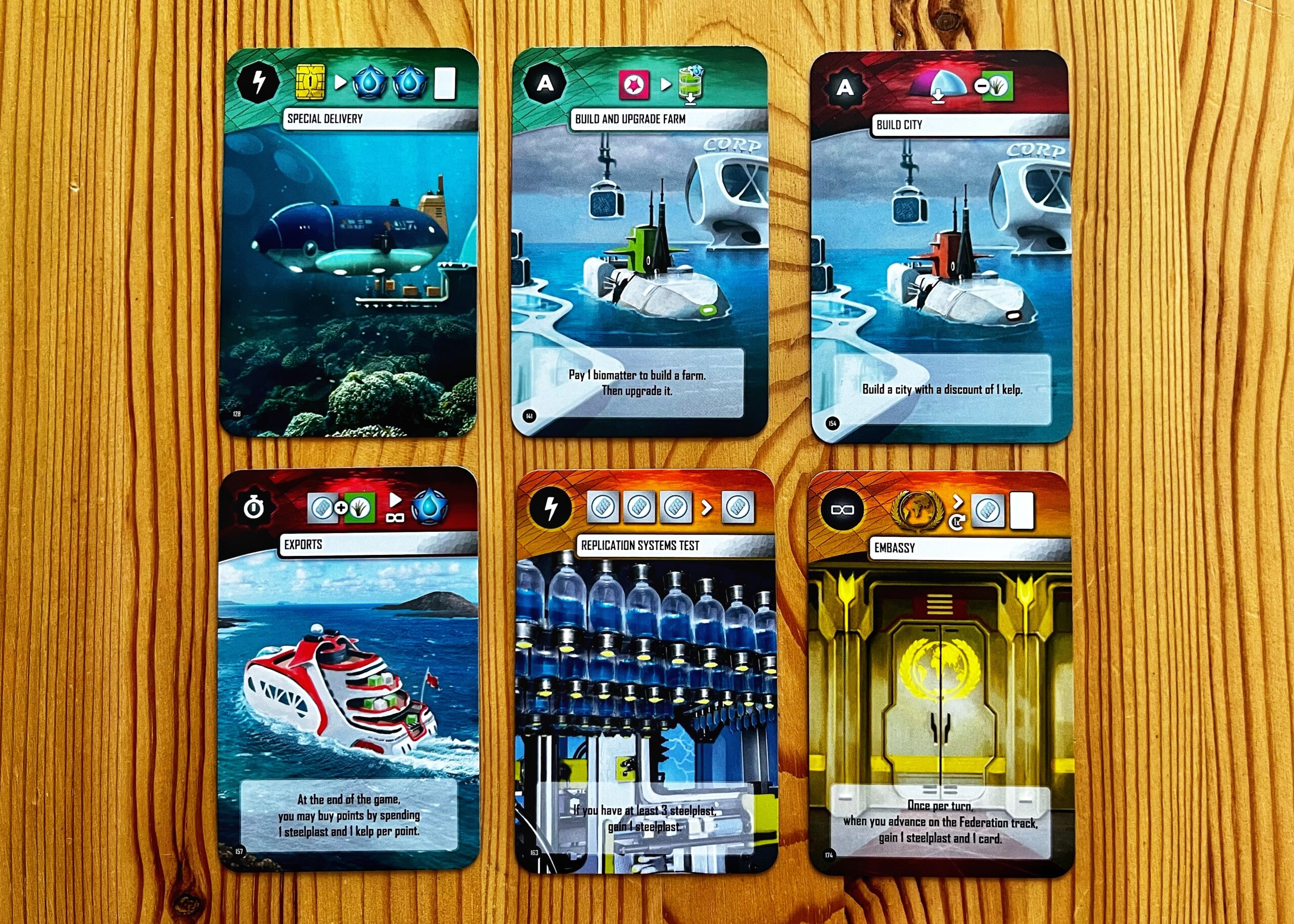
Some examples of the different cards in Underwater Cities.
Every card has a banner that matches the color of one of three action slot colors: green, red, or yellow.
Additionally, you’ll find iconography detailing the card’s effect in that banner. (This effect is also explained in words at the bottom of each card.)
Cards are either:
- Resolved immediately, and then the card is discarded or
- It’s added to a player’s tableau, and its effect is triggered when a certain condition is met.
Note that cards only ever “activate” if, when you play it, the card matches the action slot color you chose for your turn.
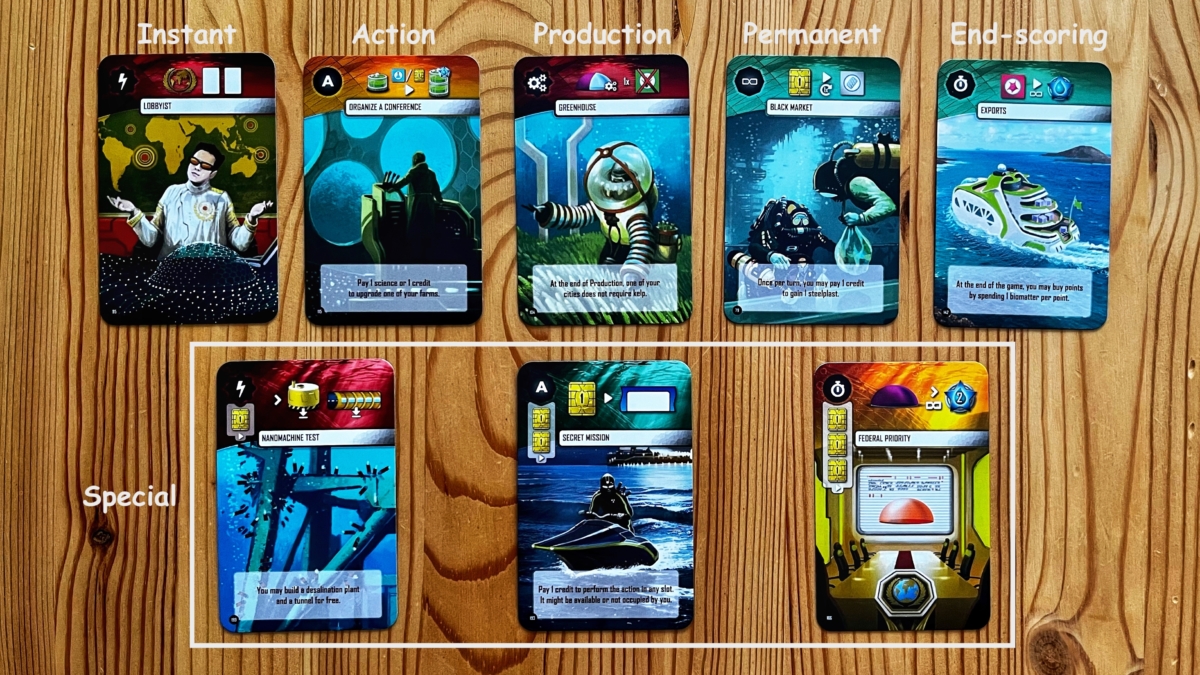
An example of a card with an instant effect, a permanent effect, an Action card, a Production card, an End-scoring card, and 3 different Special cards (as noted by their cost to play on the left).
Cards with the lightning bolt icon are instant effects; you resolve the card on your turn then the card is discarded.
The infinity symbol on cards represents a permanent effect that gives you an ongoing ability for the rest of the game.
Action cards (with an ‘A’) can only be activated by an action slot or instant card effect depicting the ‘A.’ You can only use each Action card once per era and you may only ever have 4 in your tableau.
Any cards with the Production icon are triggered during the game’s Production phases.
Cards with the stopwatch icon score points at the end of the game according to the card’s scoring condition.
Special cards are unique in that they aren’t drawn from the era deck of cards like the others; instead, a player gains 1 when they use an action slot with the ‘S’ icon.
A Special card is played on a turn the same way as other cards, but to add it to your tableau — in addition to the color having to match — you must also pay its cost in Credits.
Resources
There are 5 types of resources in Underwater Cities: Steelplast, Kelp, Science, Biomatter, and Credits.
You’ll earn these resources throughout the game from action slots, card effects, and Production phases.
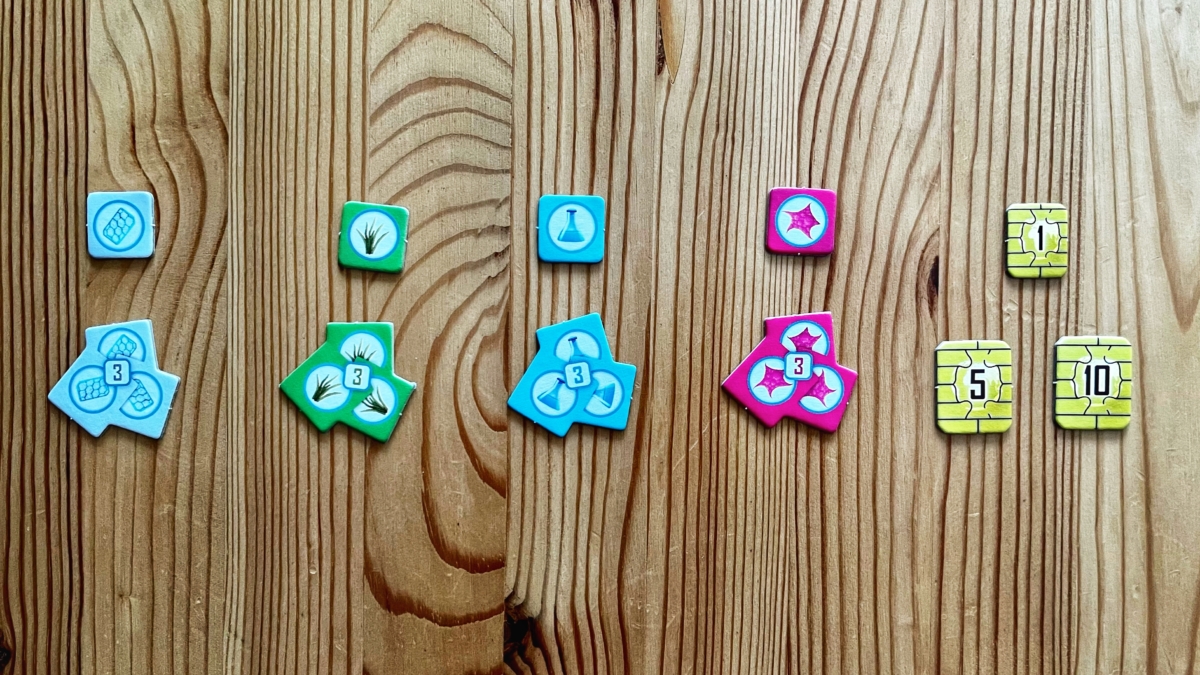
The Steelplast, Kelp, Science, Biomatter, and Credit tokens.
You must spend these resources to pay for costs, such as constructing Cities and Buildings, or upgrading Buildings and Tunnels.
Moreover, Kelp is the most efficient way to feed your connected Cities during the Production phases.
Construction
Your goal in Underwater Cities is to expand your underwater network to score the most points through connected Cities, Buildings, and Tunnels on your player board.
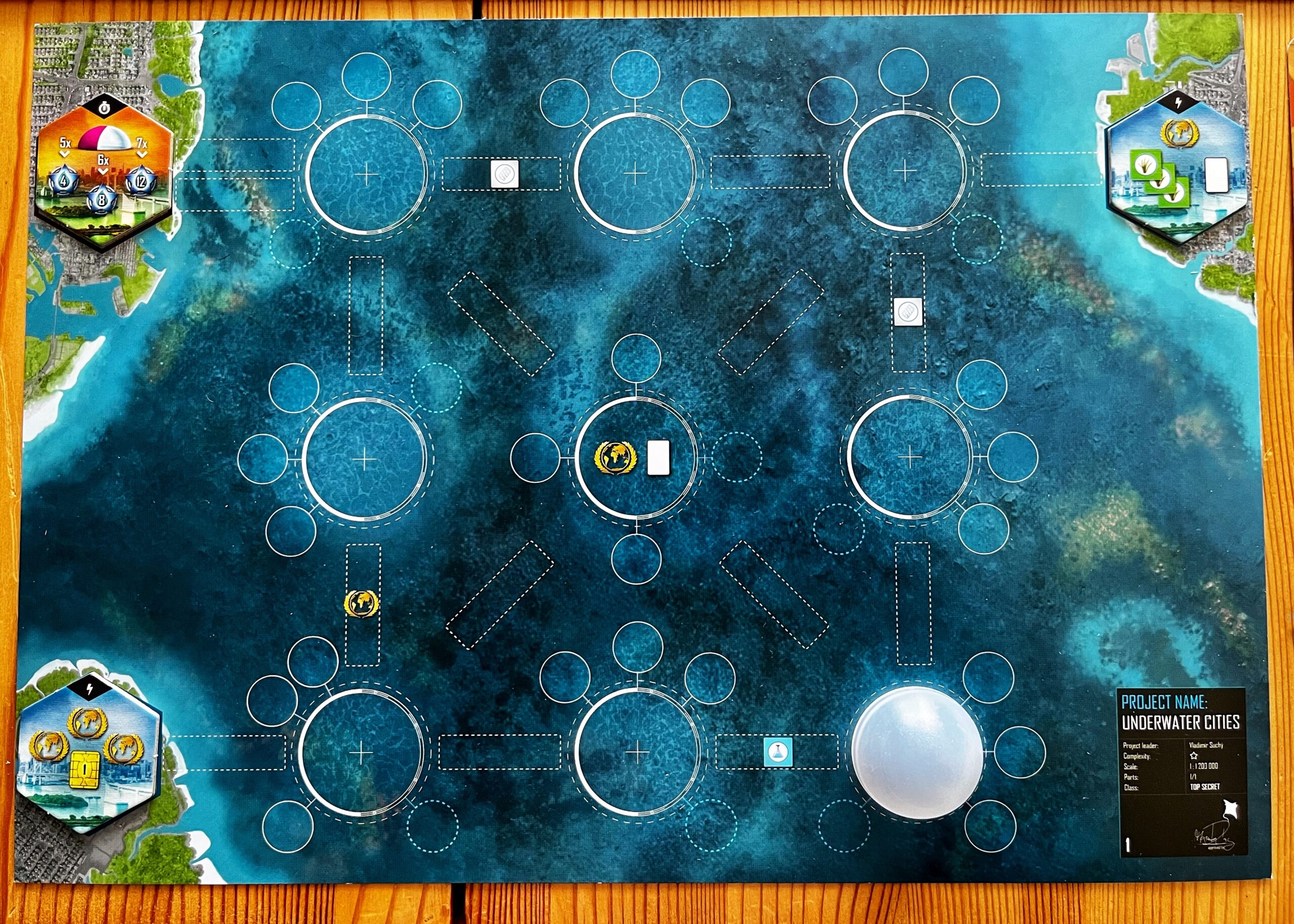
A player’s board at the beginning of the game. They start with 1 Nonsymbiotic city on the right (the white dome). All 4 player boards are unique and double-sided.
Cities
There are 2 distinct kinds of Cities that you can build: symbiotic (purple dome) and nonsymbiotic (white).
Both types of Cities need the same amount of food and score you the same number of points if they’re connected to your network at the end of the game.
Other than their cost to build, the difference is that connected Symbiotic Cities score 2 points during the Production phases, whereas Nonsymbiotic Cities produce nothing.
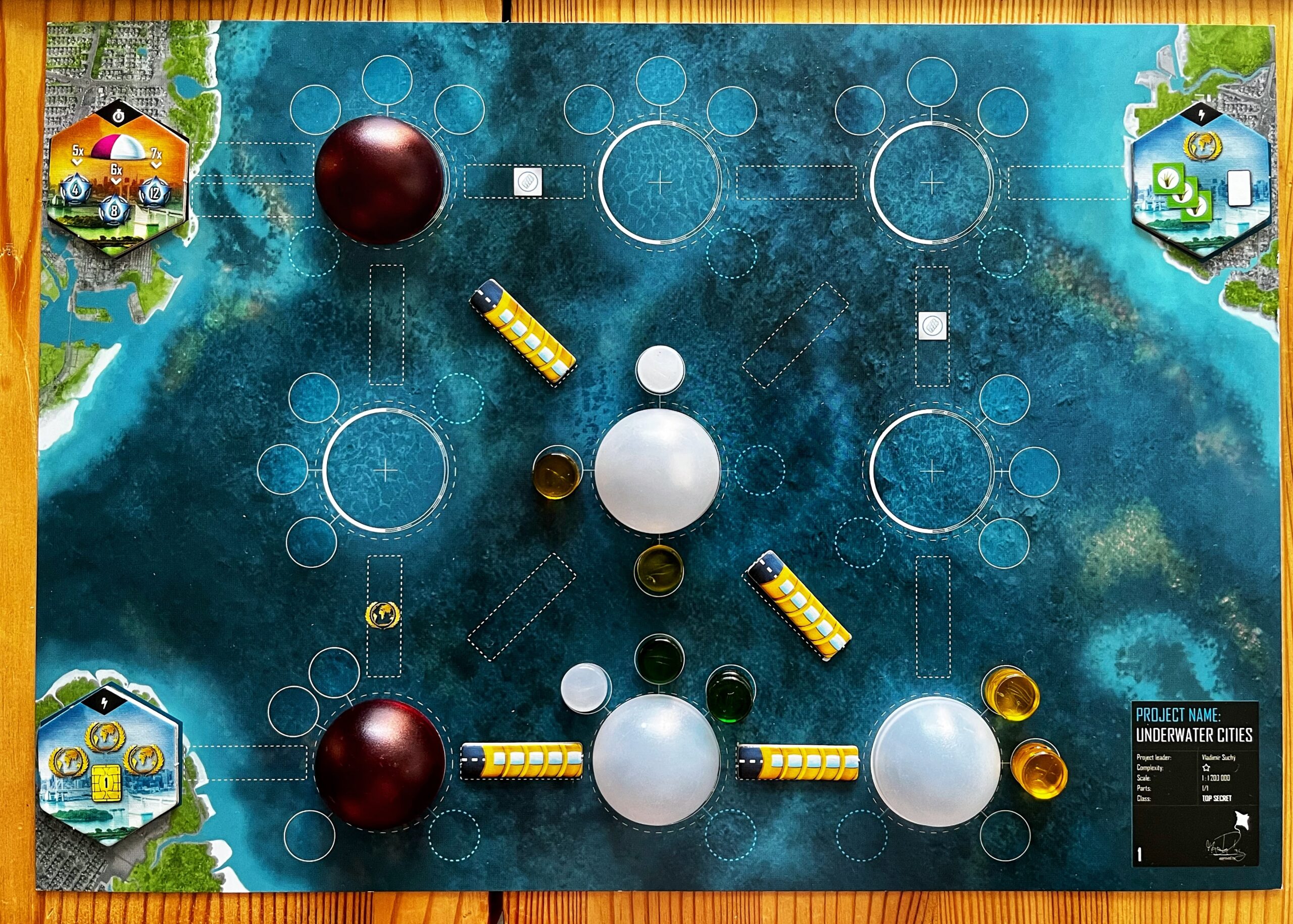
This player has 5 Cities: 3 Nonsymbiotic and 2 Symbiotic. They will have to pay 1 Kelp per connected City (5 in total) to feed their people during the Production phases. In addition, their Symbiotic Cities score them 2 points each during these phases.
Buildings
There are 3 types of Buildings you can construct adjacent to your Cities: green Farms, yellow Desalination Plants, and white Laboratories.
Each Building generates resources during Production — and even more if it’s upgraded or paired with another upgraded Building of the same type.
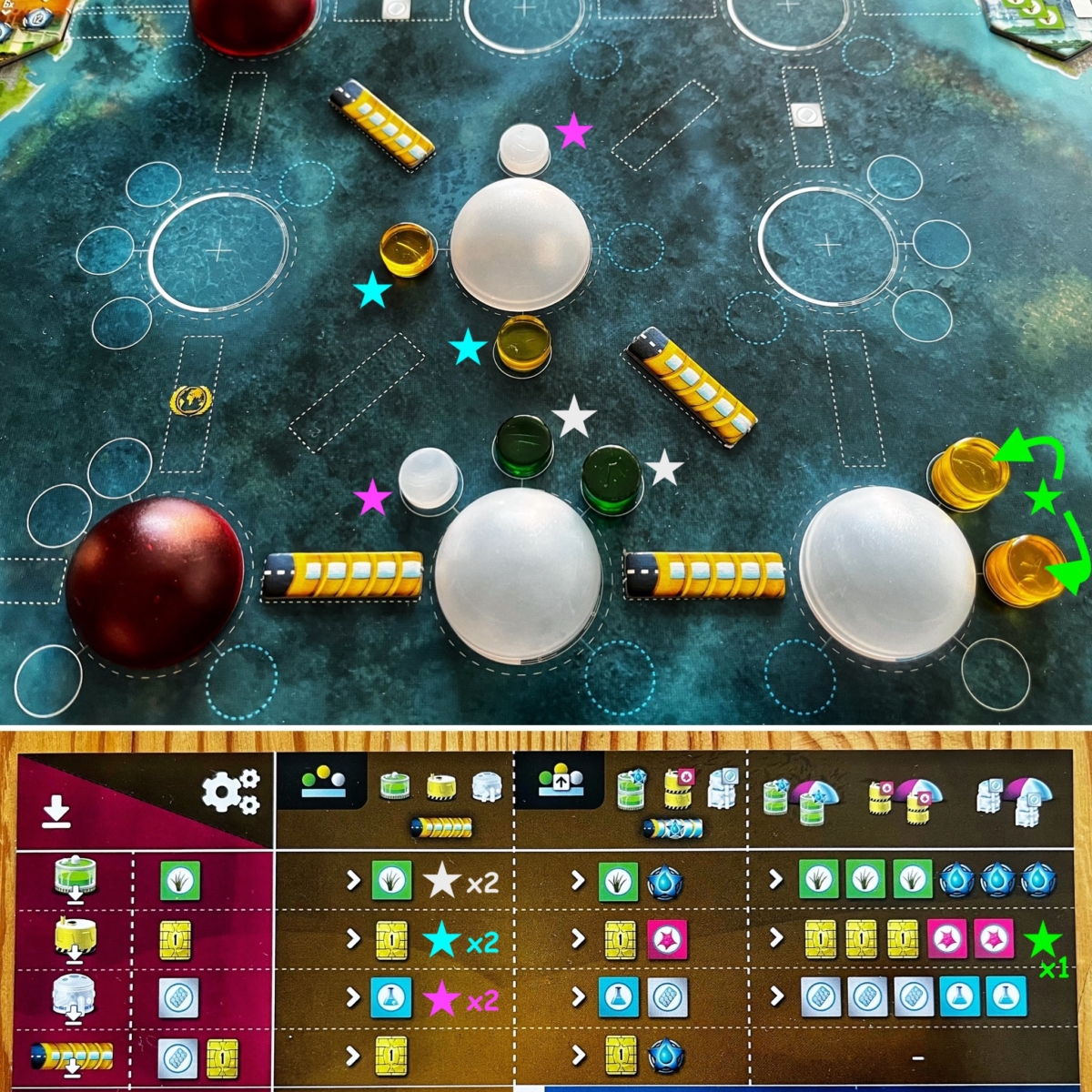
With 2 connected, non-upgraded Farms, Laboratories, and Desalination Plants, this player would earn 2 Kelp, 2 Credit, and 2 Science tokens during the Production phase (as shown by the white, blue, and pink stars, respectively). Moreover, they would gain 3 Credit and 2 Biomatter tokens for their 2 upgraded Desalination Plants adjacent to a City (as shown in green).
Tunnels
Tunnels are used to connect your underwater Cities — and their adjacent Buildings — on your player board into one efficient underwater network.
Anything not connected to your starting City through Tunnels won’t produce during Production and won’t score at the end of the game.
Tunnels also earn you money (and points if upgraded) during the Production phase.
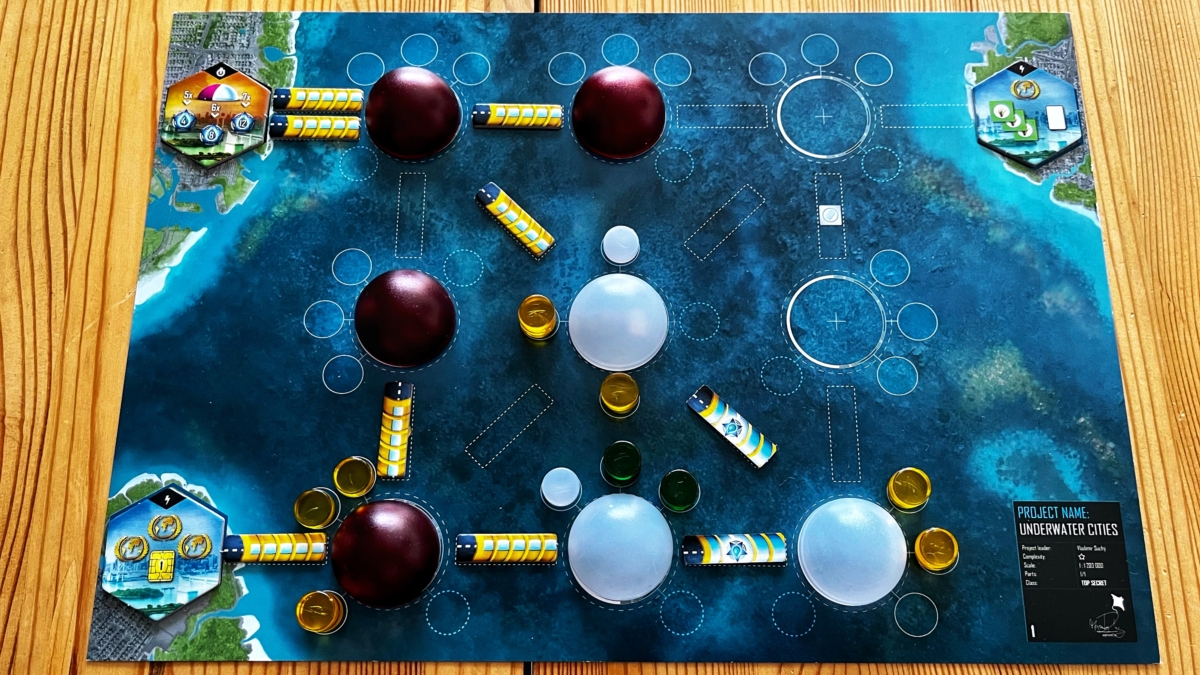
Everything on this player’s board is connected through the 9 Tunnels (except for the blue Metropolis tile in the top right corner).
Final Scoring
picture underwater cities final scoring card. Caption: A Final Scoring card.
At the end of era III — 10 rounds and the last Production phase — you score points in this order for:
- The brown Metropolis tile on your player board if it’s connected to your underwater network.
- Any End-scoring cards added to your tableau during the game.
- Your network (for each connected City and adjacent Buildings).
- Leftover resources by converting them into Credits and buying points (1 point for every 4 credits).
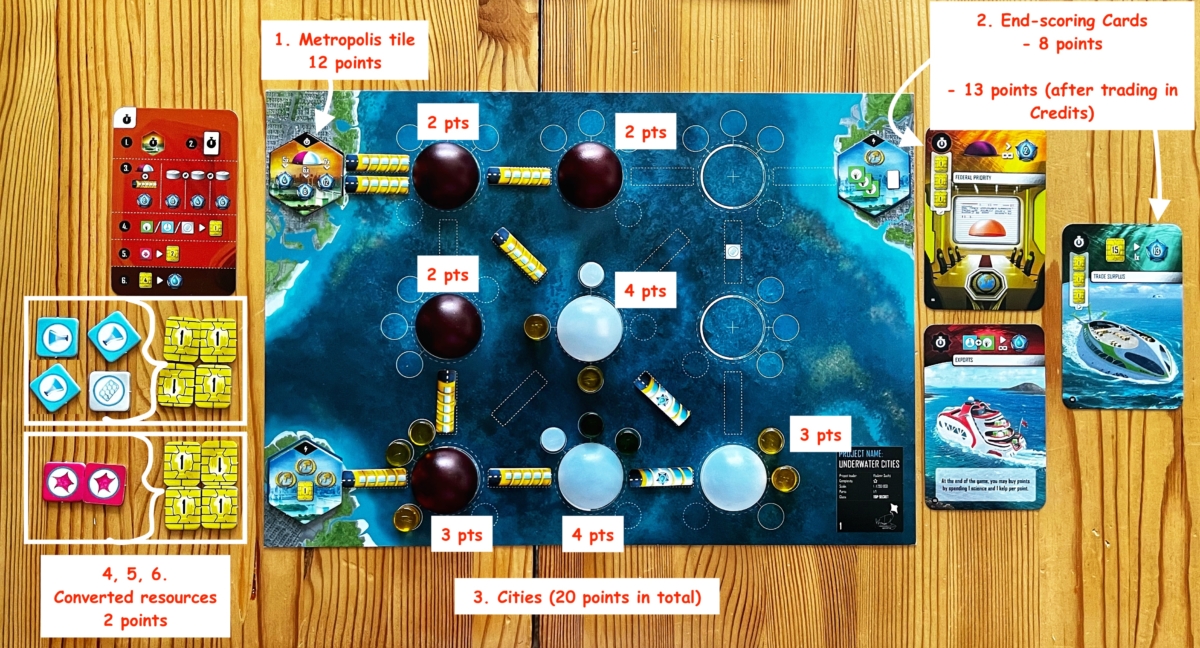
An example of what this player scores at the end of the game.
Underwater Cities Review
Underwater Cities was one of the rare games where I read the rulebook and knew immediately that I would enjoy it.
Not only is it designed by one of my favorite designers, Vladimír Suchý, but it’s a Euro game centered on two game mechanics I love — card-based tableau- and engine-building.
Games with these mechanics allow you to carve your own path and create an engine for yourself to then combo the various effects you gain during the game.
In Underwater Cities, these effects are acquired through card play.
Much of the tension, however, lies in the worker placement aspect of the game
There is always so much you want to do, but not only will you feel like you don’t have enough turns, you’ll often find your most efficient path to victory will be blocked by your opponents.
Because every move you make can feel so important, the game tends to run a little longer at the higher player counts because even the fastest players will need some thinking time on their turn. However, the game doesn’t ever feel like it drags on.
Production Phases
The game is most satisfying for me during the Production phases because the flow and pacing of the game allow you to reap the rewards of your efforts.
There is such a satisfying feeling of wealth, especially late in the game, as you amass all the resources and points produced by the underwater network you’ve developed.
Balancing
Underwater Cities does a great job balancing the power of everything — on the board as action slots and their various matching-colored cards.
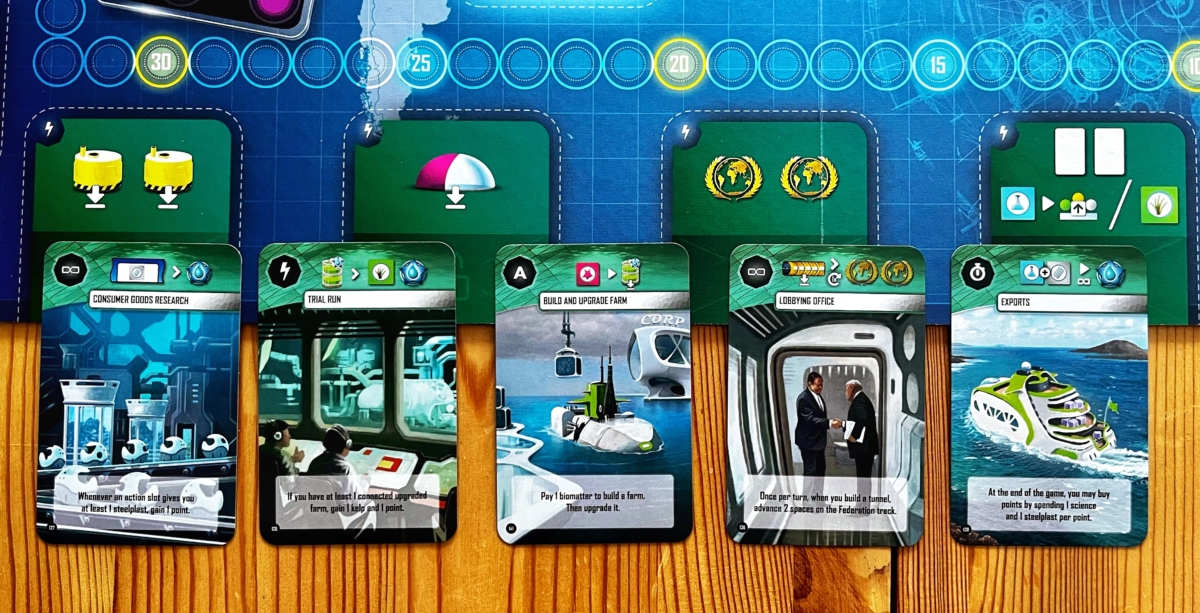
A few examples of green cards alongside the 4 green action slots for a 2-player game. In comparison to red and yellow, green cards are the strongest, but their action slots are the weakest.
Also, having the cards divided into 3 different eras is crucial.
How UnderwaterCities handles this progression of the cards is a huge improvement compared to other card-based Euro engine-building games (like Terraforming Mars, for example).
Player Aids and Other Components
Once you understand how to read them, the player aids are a fantastic — and necessary — resource for the game.
The iconography, too, is solid. Since Underwater Cities is such a heavy and thinky game, you are able to save your mental energy for your gameplay and strategy.
However, the physical quality of many components could be more impressive. The player boards and aids, and the cards are shockingly thin and flimsy.
There also aren’t nearly enough resources, especially in 3- and 4-player games, so you constantly have to make change and that kind of admin can be fiddly and annoying.
Final Thoughts
If you’re a fan of heavier card-based, engine-building Euro games, then Underwater Cities is one you should check out without hesitation; it combines these mechanics well, making for a fantastic game.
You might also be interested in the following:

